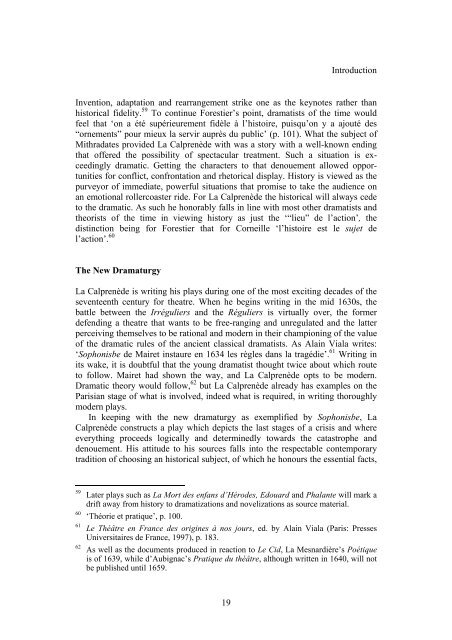LA MORT DE MITRIDATE - University of Liverpool
LA MORT DE MITRIDATE - University of Liverpool
LA MORT DE MITRIDATE - University of Liverpool
You also want an ePaper? Increase the reach of your titles
YUMPU automatically turns print PDFs into web optimized ePapers that Google loves.
Introduction<br />
Invention, adaptation and rearrangement strike one as the keynotes rather than<br />
historical fidelity. 59 To continue Forestier’s point, dramatists <strong>of</strong> the time would<br />
feel that ‘on a été supérieurement fidèle à l’histoire, puisqu’on y a ajouté des<br />
“ornements” pour mieux la servir auprès du public’ (p. 101). What the subject <strong>of</strong><br />
Mithradates provided La Calprenède with was a story with a well-known ending<br />
that <strong>of</strong>fered the possibility <strong>of</strong> spectacular treatment. Such a situation is exceedingly<br />
dramatic. Getting the characters to that denouement allowed opportunities<br />
for conflict, confrontation and rhetorical display. History is viewed as the<br />
purveyor <strong>of</strong> immediate, powerful situations that promise to take the audience on<br />
an emotional rollercoaster ride. For La Calprenède the historical will always cede<br />
to the dramatic. As such he honorably falls in line with most other dramatists and<br />
theorists <strong>of</strong> the time in viewing history as just the ‘“lieu” de l’action’, the<br />
distinction being for Forestier that for Corneille ‘l’histoire est le sujet de<br />
l’action’. 60<br />
The New Dramaturgy<br />
La Calprenède is writing his plays during one <strong>of</strong> the most exciting decades <strong>of</strong> the<br />
seventeenth century for theatre. When he begins writing in the mid 1630s, the<br />
battle between the Irréguliers and the Réguliers is virtually over, the former<br />
defending a theatre that wants to be free-ranging and unregulated and the latter<br />
perceiving themselves to be rational and modern in their championing <strong>of</strong> the value<br />
<strong>of</strong> the dramatic rules <strong>of</strong> the ancient classical dramatists. As Alain Viala writes:<br />
‘Sophonisbe de Mairet instaure en 1634 les règles dans la tragédie’. 61 Writing in<br />
its wake, it is doubtful that the young dramatist thought twice about which route<br />
to follow. Mairet had shown the way, and La Calprenède opts to be modern.<br />
Dramatic theory would follow, 62 but La Calprenède already has examples on the<br />
Parisian stage <strong>of</strong> what is involved, indeed what is required, in writing thoroughly<br />
modern plays.<br />
In keeping with the new dramaturgy as exemplified by Sophonisbe, La<br />
Calprenède constructs a play which depicts the last stages <strong>of</strong> a crisis and where<br />
everything proceeds logically and determinedly towards the catastrophe and<br />
denouement. His attitude to his sources falls into the respectable contemporary<br />
tradition <strong>of</strong> choosing an historical subject, <strong>of</strong> which he honours the essential facts,<br />
59<br />
60<br />
61<br />
62<br />
Later plays such as La Mort des enfans d’Hérodes, Edouard and Phalante will mark a<br />
drift away from history to dramatizations and novelizations as source material.<br />
‘Théorie et pratique’, p. 100.<br />
Le Théâtre en France des origines à nos jours, ed. by Alain Viala (Paris: Presses<br />
Universitaires de France, 1997), p. 183.<br />
As well as the documents produced in reaction to Le Cid, La Mesnardière’s Poétique<br />
is <strong>of</strong> 1639, while d’Aubignac’s Pratique du théâtre, although written in 1640, will not<br />
be published until 1659.<br />
19
















